Metallogenic Material Source and Genesis of the Jilinbaolige Pb-Zn-Ag Deposit, the Great Xing’an Range, China: Constraints from Mineralogical, S Isotopic, and Pb Isotopic Studies of Sulfide Ores
Abstract
:1. Introduction
2. Regional Geological Background
3. Geological Characteristics of Ore Deposit
3.1. Geological Overview of the Jilinbaolige Mining Area
3.2. Characteristics of Ore Bodies, Ores, and Surrounding Rocks
3.3. Metallogenic Stages
- 1.
- Arsenopyrite–pyrite–chalcopyrite–sphalerite stage: Arsenopyrite, pyrite, chalcopyrite, and sphalerite are the main mineral assemblages in this stage. Under the microscope, early-crystallized arsenopyrite and pyrite show good automorphism. Pyrites are mostly medium-fine-grained euhedral and subhedral cubic grains (Figure 2a), whereas arsenopyrite is mostly fine-grained euhedral and subhedral short, columnar. granular crystals, showing dissolution of the early-crystallized pyrite (Figure 2b,c). The late-crystallized pyrites are relatively less, mostly micro-fine-grained xenomorphic and filling fissures in early arsenopyrite fissures as a fine-vein metasomatic structure (Figure 2d).
- 2.
- Galena–sphalerite–quartz stage: This stage is an important metallogenic stage of the hydrothermal period, and the ore minerals are mainly galena and sphalerite. Galena occurs as granular aggregates. Under the microscope, galena often fills along grain margins, fissures, and pores, replacing the other sulfide minerals (Figure 2e). Sphalerite occurs in solid solution with chalcopyrite and is cut by galena (Figure 2f).
- 3.
- Pyrite–calcite–quartz stage: This assemblage marks the culmination of the hydrothermal stage, mainly represented by carbonation. The main mineral assemblage is quartz + calcite + pyrite.
4. Analytical Method
5. Results
6. Discussion
6.1. Metallogenic Environment
6.2. Source of Ore-Forming Materials
6.2.1. Source of Sulfur
6.2.2. Sources of Lead
6.3. Origin of Ore Deposits in the Region
7. Conclusions
Author Contributions
Funding
Data Availability Statement
Conflicts of Interest
References
- Wang, R.L.; Zeng, Q.D.; Zhang, Z.C.; Zhou, L.L.; Qin, K.Z. Extensive mineralization in the eastern segment of the Xingmeng orogenic belt, NE China: A regional view. Ore Geol. Rev. 2021, 135, 104204. [Google Scholar] [CrossRef]
- Zeng, Q.D.; Qin, K.Z.; Liu, J.M.; Li, G.M.; Zhai, M.G.; Chu, S.X.; Guo, Y.P. Porphyry molybdenum deposits in the Tianshan–Xingmeng orogenic belt, northern China. Int. J. Earth Sci. 2015, 104, 991–1023. [Google Scholar] [CrossRef]
- Zeng, Q.D.; Liu, J.M.; Chu, S.X.; Wang, Y.B.; Sun, Y.; Duan, X.X.; Zhou, L.L. Mesozoic molybdenum deposits in the East Xingmeng orogenic belt, northeast China: Characteristics and tectonic setting. Int. Geol. Rev. 2012, 54, 1843–1869. [Google Scholar] [CrossRef]
- Zeng, Q.D.; Di, Q.Y.; Liu, T.B.; Li, G.M.; Yu, C.M.; Shen, P.; Liu, H.T.; Ye, J. Explorations of gold and lead-zinc deposits using a magnetotelluric method: Case studies in the Tianshan-Xingmeng Orogenic Belt of Northern China. Ore Geol. Rev. 2020, 117, 103283. [Google Scholar] [CrossRef]
- Han, C.M.; Xiao, W.J.; Su, B.V.; Zhang, X.H.; Wan, B.; Song, D.F.; Zhang, Z.Y.; Zhang, J.; Wang, Z.M.; Xie, M.C. Geological Characteristics and Metallogenic Setting of Representative Magmatic Cu-Ni Deposits in the Tianshan-Xingmeng Orogenic Belt, Central Asia. Acta Geol. Sin. 2019, 93, 1205–1218. [Google Scholar] [CrossRef]
- Zeng, Q.D.; Liu, J.M.; Yu, C.M.; Ye, J.; Liu, H.T. Metal deposits in the Da Hinggan Mountains, NE China: Styles, characteristics, and exploration potential. Int. Geol. Rev. 2011, 53, 846–878. [Google Scholar] [CrossRef]
- Zeng, Q.D.; Liu, J.M.; Liu, H.T. Geology and geochemistry of the Bianbianshan Au-Ag-Cu-Pb-Zn deposit, southern Da Hinggan Mountains, northeastern China. Acta Geol. Sin. 2012, 86, 630–639. [Google Scholar]
- Zhai, M.G.; Santosh, M. Metallogeny of the North China Craton: Link with secular changes in the evolving earth. Gondwana Res. 2013, 24, 275–297. [Google Scholar] [CrossRef]
- Zhang, W.Y.; Nie, F.J.; Liu, S.W.; Zuo, L.Y.; Shan, L.; Yao, X.F. Belt Characteristics and metallogenic regularities of ore deposits on the wslope of the southern section of the Da Hinggan Mountains metallogenic. Geol. China 2013, 40, 1583–1599, (In Chinese with English abstract). [Google Scholar]
- Sheng, J.F.; Fu, X.Z. Metallogenic Environment and Copper Polymetallic Deposits in Middle Da Hinggan Mts; Seismological Press: Beijing, China, 1999. (In Chinese) [Google Scholar]
- Wang, C.G.; Sun, F.Y.; Sun, G.S.; Sun, J.D.; Li, Y.; Feng, H.D. Geochronology, geochemical and isotopic constraints on petrogenesis of intrusive complex associated with Bianjiadayuan polymetallic deposit on the southern margin of the Greater Khingan, China. Arab. J. Geosci. 2016, 9, 1–16. [Google Scholar] [CrossRef]
- Mao, J.W.; Xie, G.Q.; Zhang, Z.H.; Li, X.F.; Wang, Y.T.; Zhang, C.Q.; Li, Y.F. Mesozoic large-scale metallogenic pulses in North China and corresponding geodynamic settings. Acta Petrol. Sin. 2005, 21, 169–188, (In Chinese with English abstract). [Google Scholar]
- Ouyang, H.G.; Mao, J.W.; Santosh, M.; Wu, Y.; Hou, L.; Wang, X.F. The Early Cretaceous Weilasituo Zn–Cu–Ag vein deposit in the southern Great Xing”an Range, northeast China: Fluid inclusions, H, O, S, Pb isotope geochemistry and genetic implications. Ore Geol. Rev. 2014, 56, 503–515. [Google Scholar] [CrossRef]
- Wang, J.B.; Wang, Y.W.; Wang, L.J.; Uemoto, T. Tin–polymetallic mineralization in the southern part of the Da Hinggan Mountains, China. Resour. Geol. 2001, 51, 283–291. [Google Scholar] [CrossRef]
- Yang, C. Geological Geochemistry Characteristics and Causes of Formation of the Huanaote Ag-Pb-Zn in Deposit, Inner Mongolia, China. Master’s Thesis, China University of Geosciences, Beijing, China, 2019; pp. 1–47, (In Chinese with English abstract). [Google Scholar]
- Zhang, W.Y.; Nie, F.J.; Liu, Y.; Jiang, S.H.; Xu, Z.; Hu, P.; Lai, X.R.; PI, X.d. Studies on Sulfur and Lead Isotope of the Arehada Pb-Zn-Ag Deposit, Dong Ujmqin Qi(County), Inner Mongolia. J. Jilin Univ. Earth Sci. Ed. 2007, 37, 868–877, (In Chinese with English abstract). [Google Scholar]
- Wu, X.Q.; Wang, Z.H.; Wang, L.; Chang, C.J.; Cong, R.X.; Zhang, H.Y. Geological Characteristics and Prospecting Direction of the Chaobuleng Iron Polymetallic Deposit in Inner Mongolia. Gold Sci. Technol. 2014, 22, 31–37, (In Chinese with English abstract). [Google Scholar]
- Wang, Z.H.; Ge, L.S.; Sun, L.; Chang, C.J.; Cong, R.X.; Zhang, H.Y. Geological-geochemical characteristics and genesis of Ag polymetallic deposit at 1017 highland in Dong Ujimqin Banner, Inner Mongolia. J. Mineral. Petrol. 2015, 35, 27–38, (In Chinese with English abstract). [Google Scholar]
- Wang, R.L.; Zhang, Z.C.; Zeng, Q.D.; Wang, Y.B.; Guo, Q.; Chu, H.Y.; Guo, Y.P.; Guo, L.X. The characteristics of oreforming Fluids and ore-forming mechanism of the Diyanqinamu super-large molybdenum deposit, Inner Mongolia. Acta Petrol. Sin. 2018, 34, 3582–3596, (In Chinese with English abstract). [Google Scholar]
- Jiang, H.Z.; Liu, G.F.; Liu, W.F. Geological Characteristics and Mineral Resource Prospecting of Jilinbaolige Silver Deposit,Inner Mongolia. Geol. Miner. Resour. South China 2007, 9–13, (In Chinese with English abstract). [Google Scholar]
- Lv, Z.H. Geological characteristics and prospecting direction of silver polymetallic mineralization in Baolige area, Jilin Province, Dongwu Banner, Inner Mongolia. West. Resour. 2012, 10, 155–156+158. (In Chinese) [Google Scholar]
- Lu, H. Geological characteristics and prospecting prospect analysis of the Baolige silver deposit in Jilin, Inner Mongolia. Xinjiang Youse Jinshu 2014, 37, 10–13. (In Chinese) [Google Scholar]
- Cong, R.X.; Chang, C.J.; Liu, G.G.; Qi, L.H.; Wang, Z.H.; Wang, L.; Zhang, H.Y. Preliminary study on the geology and genesis of the Jilinbaolige silver polymetallic deposit in Inner Mongolia. Geol. Resour. 2014, 23, 453–460, (in Chinese with English abstract). [Google Scholar]
- Wang, Z.H.; Cong, R.X.; Chang, C.J.; Liu, G.G.; Qi, L.H.; Wang, L.; Zhang, H.Y. Sand Pb isotopic characteristics and origin of the Jilinbaolige silver polymetallic deposit,Inner Mongolia. Miner. Depos. 2014, 33, 289–290, (in Chinese with English abstract). [Google Scholar]
- Huang, Z.J.; Wang, G.C.; Gao, R. The Relationship between Tectonic, Magmatic Activity and Ploymetallic Ore in Dongwuqi of Inner Mongolia, Take 1017 Highland Mining Area as an Example. Gold Sci. Technol. 2011, 19, 18–22, (in Chinese with English abstract). [Google Scholar]
- Zhang, W.Y.; Nie, F.J.; Liu, S.W.; Zuo, L.Y.; Yao, X.F.; Jia, D.L.; Liu, J.T. Characteristics and genesis of mineral deposits in East Ujimqin Banner, western segment of the Great Xing’an Mountains, NE China. J. Asian Earth Sci. 2015, 97, 459–471. [Google Scholar] [CrossRef]
- Dostal, J.; Svojtka, M.; Gerel, O. Randolph Corney. Early Jurassic Rare Metal Granitic Pluton of the Central Asian Orogenic Belt in North-Central Mongolia: Tungsten Mineralization, Geochronology, Petrogenesis and Tectonic Implications. Front. Earth Sci. 2020, 8, 242. [Google Scholar] [CrossRef]
- Ding, J.X.; Han, C.M.; Xiao, W.J.; Wang, Z.M.; Song, D.F. Geochronology, geochemistry and Sr-Nd isotopes of the granitic rocks associated with tungsten deposits in Beishan district, NW China, Central Asian Orogenic Belt: Petrogenesis, metallogenic and tectonic implications. Ore Geol. Rev. 2017, 89, 441–462. [Google Scholar] [CrossRef]
- Cai, K.D.; Sun, M.; Xiao, W.J.; Buslov, M.M.; Yuan, C.; Zhao, G.C.; Long, X.P. Zircon U-Pb geochronology and Hf isotopic composition of granitiods in Russian Altai Mountain, Central Asian Orogenic Belt. Am. J. Sci. 2014, 314, 580–612. [Google Scholar] [CrossRef]
- Chen, B.; Jahn, B.M.; Wilde, S.; Xu, B. Two contrasting paleozoic magmatic belts in northern Inner Mongolia, China: Petrogenesis and tectonic implications. Tectonophysics 2000, 328, 157–182. [Google Scholar] [CrossRef]
- Yarmolyuk, V.V.; Degtyarev, K.E. Precambrian Terranes of the Central Asian Orogenic Belt: Comparative Characteristics, Types, and Peculiarities of Tectonic Evolution. Geotectonics 2019, 53, 1–23. [Google Scholar] [CrossRef]
- Xu, B.; Charvet, J.; Chen, Y.; Zhao, P.; Shi, G.Z. Middle Paleozoic convergent orogenic belts in western Inner Mongolia (China): Framework, kinematics, geochronology and implications for tectonic evolution of the Central Asian Orogenic Belt. Gondwana Res. 2013, 23, 1342–1364. [Google Scholar] [CrossRef] [Green Version]
- Skoblenko, A.V.; Degtyarev, K.E. Early Paleozoic High-and Ultrahigh-Pressure Complexes in the Western Part of the Central Asian Orogenic Belt: Ages, Compositions, and Geodynamic Models of Formation. Petrology 2021, 29, 246–276. [Google Scholar] [CrossRef]
- Li, Y.K.; Gao, R.; Yao, Y.T.; Mi, S.X.; Li, W.H.; Xiong, X.S.; Gao, J.W. Crustal Velocity Structure from the Northern Margin of the North China Craton to the Southern Margin of the Siberian Plate. Chin. J. Geophys. 2014, 57, 48–63. [Google Scholar]
- Liu, J.M.; Zhang, R.; Zhang, Q.Z. The Regional Metallogeny of Da Hinggan Ling, China. Earth Sci. Front. 2004, 11, 269–277. [Google Scholar]
- Dong, Y.; Ge, W.; Yang, H.; Zhao, G.C.; Wang, Q.H.; Zhang, Y.L.; Su, L. Geochronology and geochemistry of Early Cretaceous volcanic rocks from the Baiyingaolao Formation in the central Great Xing'an Range, NE China, and its tectonic implications. Lithos 2014, 205, 168–184. [Google Scholar] [CrossRef]
- Ouyang, H.G.; Mao, J.W.; Zhou, Z.H.; Su, H.M. Late Mesozoic metallogeny and intracontinental magmatism, southern Great Xing'an Range, northeastern China. Gondwana Res. 2015, 27, 1153–1172. [Google Scholar] [CrossRef]
- Nie, F.J.; Jiang, S.H.; Bai, D.M. Metallogenic Studies and Prospecting Orientation in Central and Eastern Segment along China-Mongolia Border; Geological Publishing House: Beijing, China, 2007. (In Chinese) [Google Scholar]
- Ke, L.L. Isotopic geochemistry and evolution of ore-forming fluids of the Aerhada Pb-Zn-Ag deposit, Inner Mongolia, NE China. Master’s Thesis, China University of Geosciences, Beijing, China, 2017; pp. 1–74, (in Chinese with English abstract). [Google Scholar]
- Jia, L.Q.; Wang, Z.H.; Xu, W.Y.; Wang, L.; Li, X.; Chang, C.J. Geological and geochemical characteristics and genesis of silver-lead-zinc deposit at 1017 Highland in Dong Ujimqin Banner, Inner Mongolia. Geol. Explor. 2014, 50, 550–563, (in Chinese with English abstract). [Google Scholar]
- Chen, P.F. Study on Material Composition and Genesis of the Chaobuleng Fe Polymetallic Deposit, Inner Mongolia. Master’s Thesis, China University of Geosciences, Beijing, China, 2018; pp. 1–85, (in Chinese with English abstract). [Google Scholar]
- Bralia, A.; Sabatini, G.; Troja, F. Revaluation of the Co/Ni ratio in pyrite as geochemical tool in ore genesis problems. Miner. Depos. 1979, 14, 353–374. [Google Scholar] [CrossRef]
- Brill, B.A. Trace-element contents and partitioning of elements in ore minerals from the CSA Cu-Pb-Zn Deposit, Australia, and implications for ore genesis. Can. Miner. 1989, 27, 263–274. [Google Scholar]
- Mei, J.M. Chemical Typomorphic Characteristic of Pyrites from Zhilingtou Gold Deposit, Suichang, Zhejiang. Geoscience 2000, 14, 51–55, (in Chinese with English abstract). [Google Scholar]
- Liu, Y.; Ge, W.S.; Wu, C.; Zhang, L.L.; Nie, J.J.; Wang, J.P.; Song, W.J. Discoveryof Native Bismuth and Fluid Evolution Characteristics of the Weiquan Silver Deposit, Eastern Tianshan. Bull. Mineral. Petrol. Geochem. 2017, 36, 121–133. [Google Scholar]
- Cathelineau, M.; Nieva, D. A Chlorite Solid Solution Geothermometer the Los Azufres (Mexico) Geothermal System. Contrib. Mineral. Petrol. 1985, 91, 235–244. [Google Scholar] [CrossRef]
- Cathelineau, M. The Chlorite and Illite Geothermometers. Chem. Geol. 1988, 70, 182. [Google Scholar] [CrossRef]
- Ohmoto, H. Stable isotope geochemistry of ore deposits. Rev. Mineral. Geochem. 1983, 16, 491–559. [Google Scholar]
- Hoefs, J. Stable Isotope Geochemistry, 4th ed.; Springer: Berlin/Heidelberg, Germany, 1997; pp. 199–201. [Google Scholar]
- Ohmoto, H. Systematics of sulfur and carbon isotopes in hydrothermal ore deposits. Econ. Geol. 1972, 67, 551–578. [Google Scholar] [CrossRef]
- Ohmoto, H.; Rye, R.O. Isotopes of sulfur and carbon. In Geochemistry of Hydrothermal Ore Deposits, 2nd ed.; Barnes, H.L., Ed.; Wiley: New York, NY, USA, 1979; pp. 509–567. [Google Scholar]
- Wu, Y.L.; Mei, Y.W.; Liu, P.C.; Cai, C.L.; Lu, T.Y. Geology of Xihuashan Tungsten Deposit; Geological Press: Beijing, China, 1987; pp. 1–280. (In Chinese) [Google Scholar]
- Zheng, Y.F.; Chen, J.F. Stable Isotope Geochemistry; Science Press: Beijing, China, 2000; pp. 153–270. (In Chinese) [Google Scholar]
- Zhang, W.Y. Magmatic activities and metal mineralization in Wuzhumuqin of Inner Mongolia. Ph.D. Thesis, Chinese Academy of Geological Sciences, Beijing, China, 2008; pp. 1–169, (in Chinese with English abstract). [Google Scholar]
- Du, H. Studies on Material Composition and Genesis of the Jilinbaolige Deposit in Inner Mongolia. Master’s Thesis, China University of Geosciences, Beijing, China, 2018; pp. 1–55, (in Chinese with English abstract). [Google Scholar]
- Zhang, L.G. The application of the stable isotope to geology—The hydrothermal mineralization of metal activation and its prospecting. Miner. Depos. 1986, 61, (in Chinese with English abstract). [Google Scholar]
- Hoefs, J. Stable Isotope Geochemistry, 6th ed.; Springer: Berlin/Heidelberg, Germany, 2009; pp. 1–285. [Google Scholar]
- Bi, X.W.; Hu, R.Z.; Cornell, D.H. Trace element and isotope evidence for the evolution of ore-forming fluid of Yao,an gold deposit, Yunnan Province, China. Geochimica 2001, 30, 264–272, (in Chinese with English abstract). [Google Scholar]
- Macfarlane, A.W.; Marcet, P.; LeHuray, A.P.; Petersen, U. Lead isotope provinces of the central Andes inferred from ores and crustal rocks. Econ. Geol. 1990, 85, 1857–1880. [Google Scholar] [CrossRef]
- Chiaradia, M.; Fontbote, L.; Paladines, A. Metal sources in mineral deposits and crustal rocks of Ecuador (1°N-4°S): A lead isotope synthesis. Econ. Geol. 2004, 99, 1085–1106. [Google Scholar]
- Stacey, J.S.; Kramers, J.D. Approximation of terrestrial lead isotope evolution by a two-stage model. Earth Planet. Sci. Lett. 1975, 26, 207–221. [Google Scholar] [CrossRef]
- Doe, B.R.; Zartman, R.E. Plumbotectonics, the Phanerozoic. In Geochemistry of Hydrothermal Ore Deposits, 2nd ed.; Barnes, H.L., Ed.; Wiley: New York, NY, USA, 1979; pp. 22–70. [Google Scholar]
- Zartman, R.E.; Doe, B.R. Plumbotectonics-the model. Tectonophysics 1981, 75, 135–162. [Google Scholar] [CrossRef]
- Kamona, A.F.; Lévêque, J.; Friedrich, G.; Haack, U. Lead isotopes of the carbonate-hosted Kabwe, Tsumeb, and Kipushi Pb-Zn-Cu sulphide deposits in relation to Pan African orogenesis in the Damaran-Lufilian fold belt of Central Africa. Miner. Depos. 1999, 34, 273–283. [Google Scholar] [CrossRef]
- Zhao, Y.M.; Zhang, D.Q. Metallogeny and Prospective Evaluation of Copper Polymetallic Deposits in the Da Hinggan Mountains and its Adjacent Regions; Seismic Publisher: Beijing, China, 1997; pp. 48–82. (In Chinese) [Google Scholar]
- Zhu, X.Q.; Zhang, Q.; He, Y.L.; Zhu, C.H.; Huang, Y. Hydrothermal source rocks of the Meng'entaolegai Ag-Pb-Zn deposit in the granite batholith, Inner Mongolia,China: Constrained by isotopic geochemistry. Geochem. J. 2006, 40, 265–275. [Google Scholar] [CrossRef] [Green Version]
- Chu, X.L.; Huo, W.G.; Zhang, X. Sulfur, Carbon and Lead Isotope Studies of the Dajing Polymetallic Deposit in Linxi County, Inner Mongolia, China-Implication for Metallogenic Elements from Hypomagmatic Source. Resou. Geol. 2010, 51, 333–344. [Google Scholar] [CrossRef]
- Jiang, S.H.; Nie, F.J.; Liu, Y.F.; Yun, F. Sulfur and lead isotopic compositions of Bairendaba and Weilasituo silver-polymetallic deposits, Inner Mongolia. Min. Depos. 2010, 29, 101–112. [Google Scholar]
- Zeng, Q.D.; Liu, J.M.; Zhang, Z.L.; Jia, C.S.; Yu, C.M.; Ye, J.; Liu, H.T. Geology and lead-isotope study of the Baiyinnuoer Zn–Pb–Ag deposit, south segment of the DaHinggan Mountains, Northeastern China. Resour. Geol. 2009, 59, 170–180. [Google Scholar] [CrossRef]
- Sheng, Z.; Chen, Y.Q.; Guo, X.G. Felsic Igneous Rocks in the Hua'aobaote Pb-Zn-Ag Polymetallic Orefield, Southern Great Xing'an Range: Genesis, Metallogenetic and Tectonic Significance. Acta Geol. Sin. (Engl. Ed. ) 2022, 96, 221–239. [Google Scholar] [CrossRef]
- Yang, F.; Sun, J.G.; Wang, Y.; Fu, J.Y.; Na, F.C.; Fan, Z.Y.; Hu, Z.Z. Geology, Geochronology and Geochemistry of Weilasituo Sn-Polymetallic Deposit in Inner Mongolia, China. Minerals 2019, 9, 104. [Google Scholar] [CrossRef]
- Zhu, B.Q. Theory and Application of Isotope System in Earth Science: Also on the Evolution of the Crust and Mantle of the Chinese Mainland; Science Press: Beijing, China, 1998. (In Chinese) [Google Scholar]
- Gerel, O. Phanerozoic felsic magmatism and related mineralization in Mongolia. Bull. Geol. Surv. Jpn. 1998, 49, 239–248. [Google Scholar]

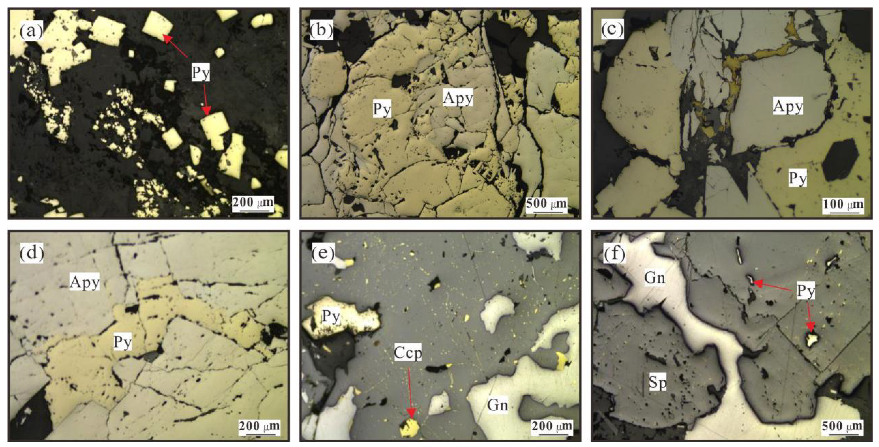
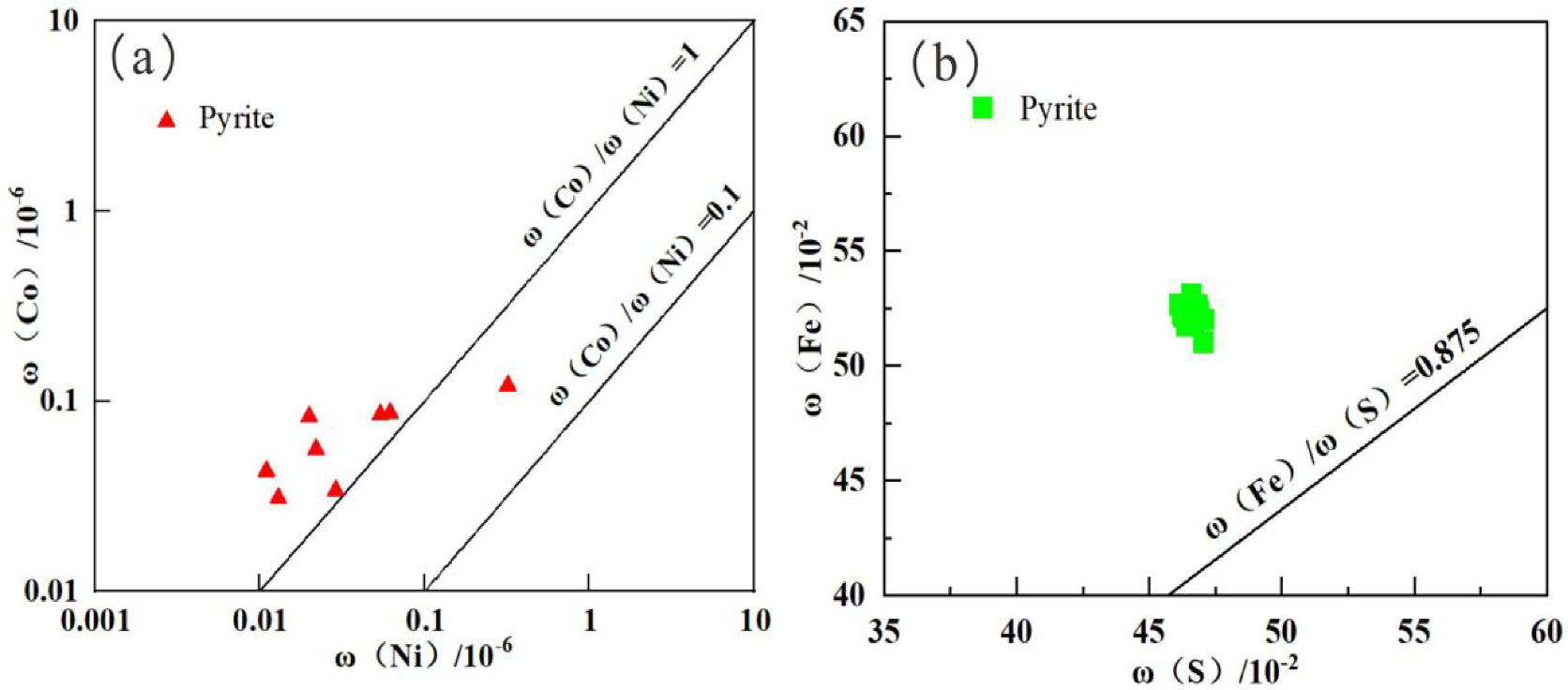
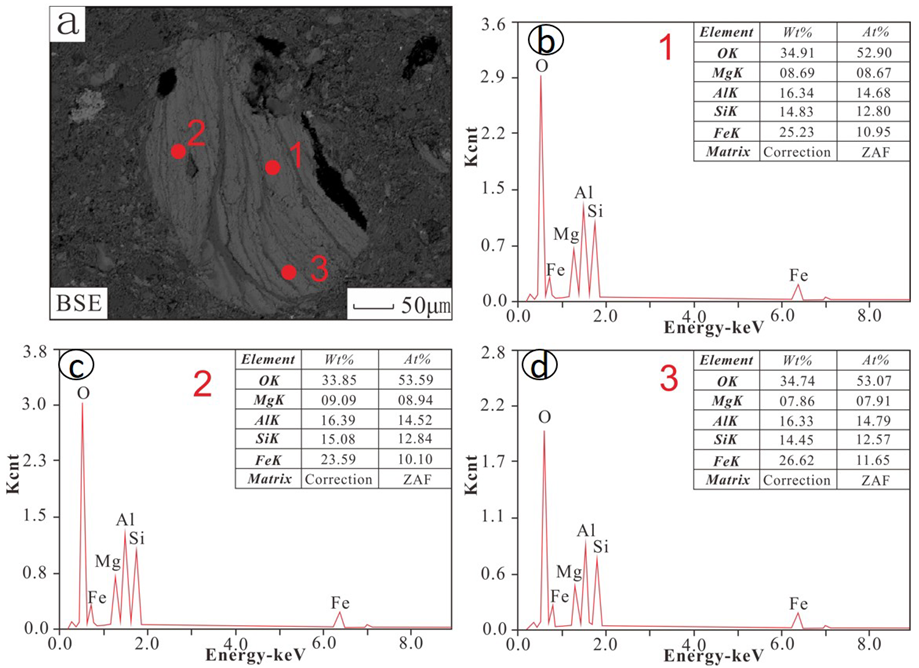
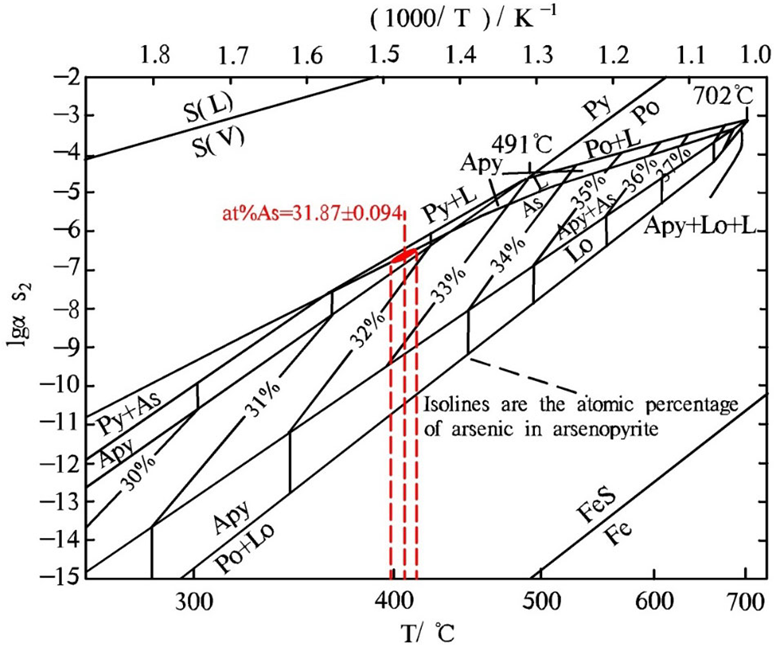
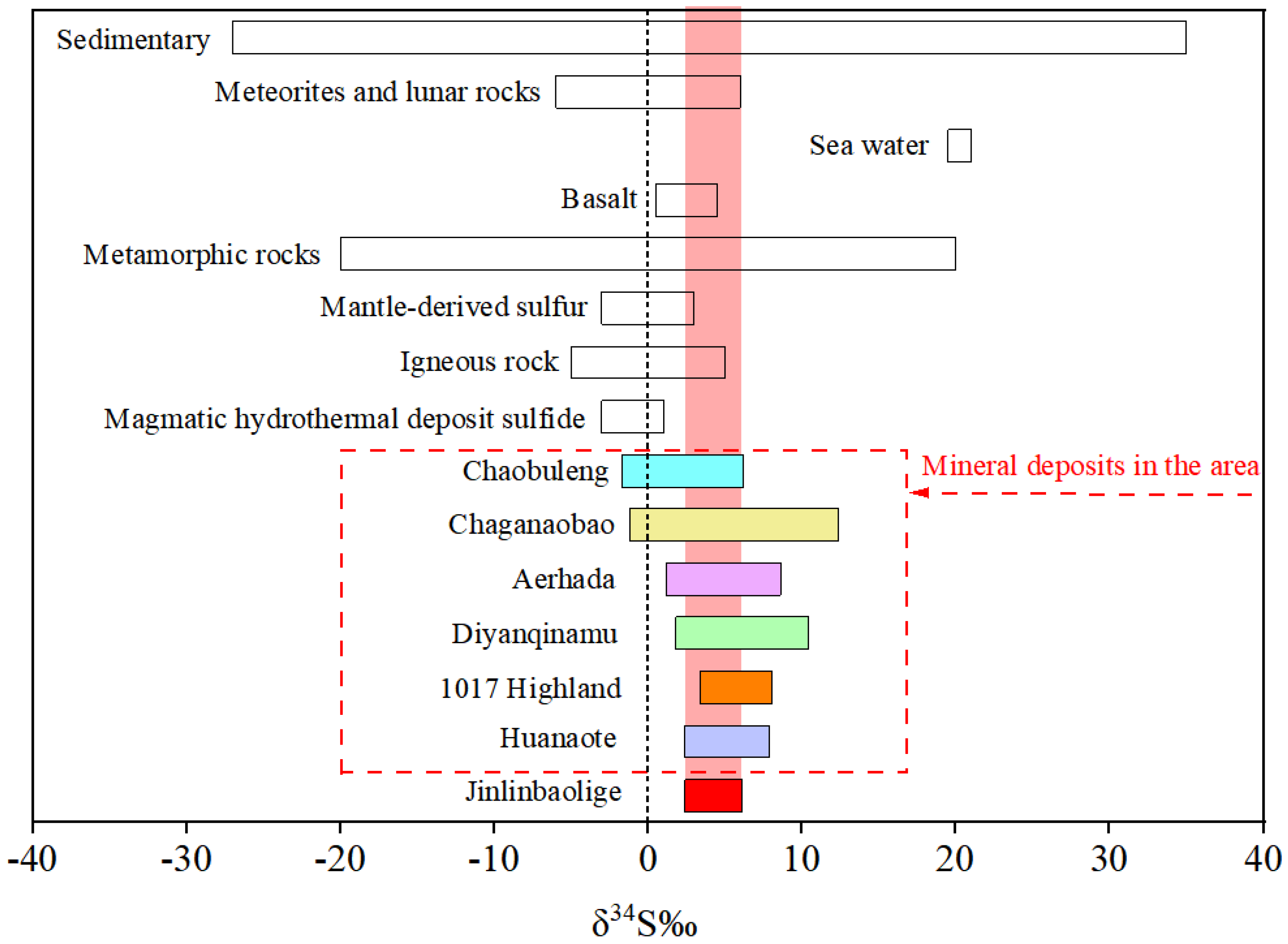

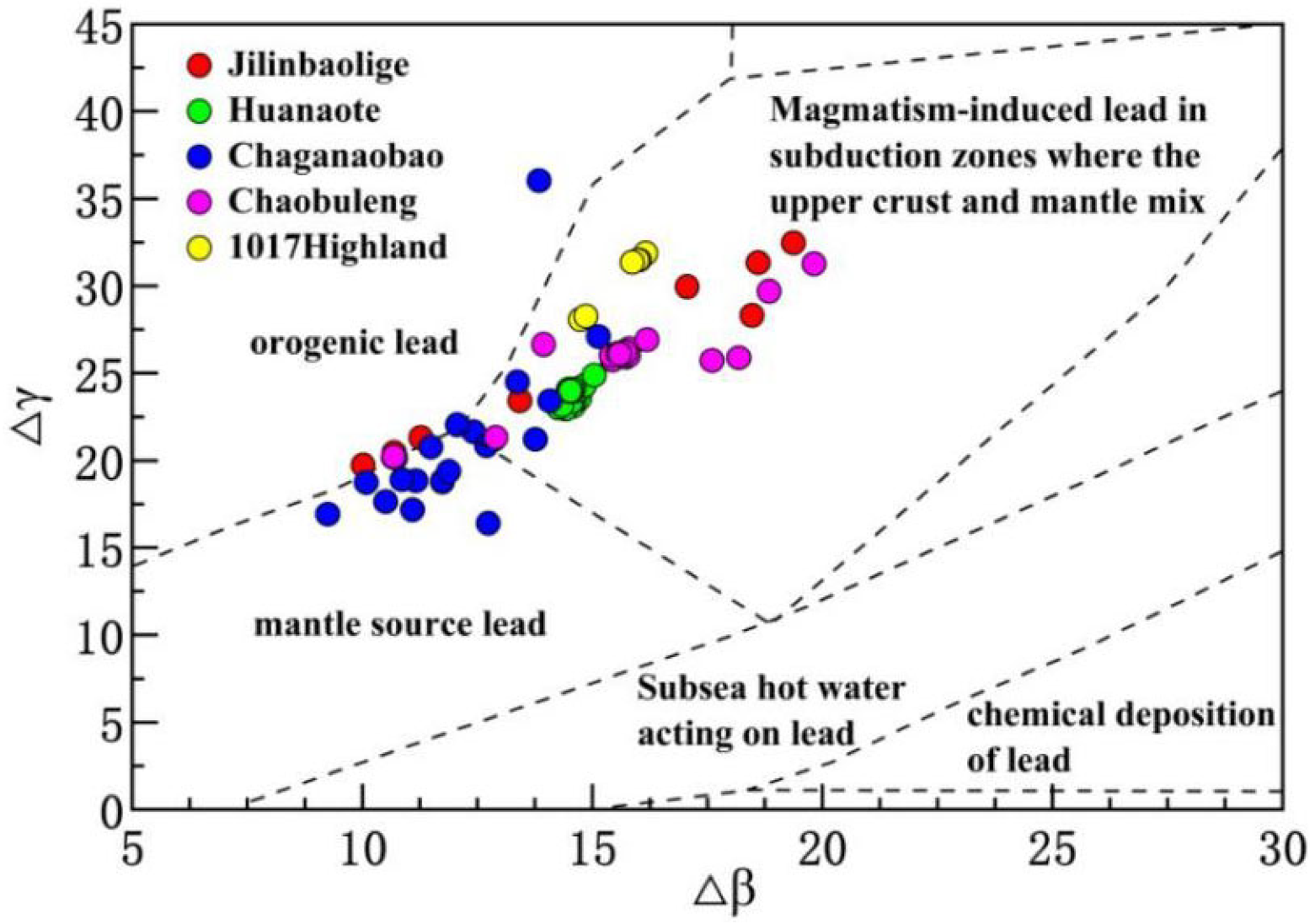
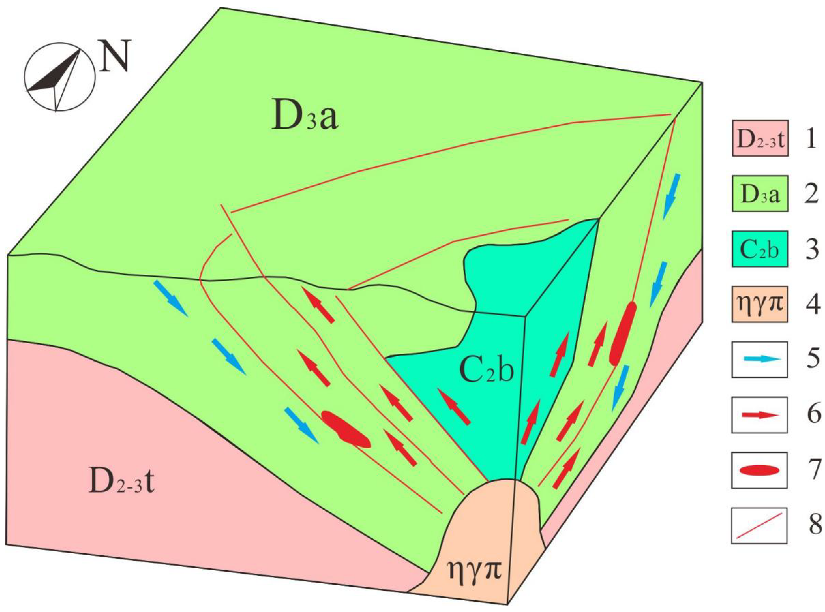
| Ore Body Number | The Maximum Length/m | Average Thickness of Ore Body/m | Average Grade | Occurrence | ||||
|---|---|---|---|---|---|---|---|---|
| Pb/% | Zn/% | Ag/10−6 | Toward | Tendency | Inclination | |||
| 2 | 610 | 2.26 | 0.65 | 1.07 | 45.26 | 0–10° | 270° | 35–50° |
| 4 | 410 | 1.08 | 0.49 | 1.52 | 19.88 | 0–10° | 270–280° | 45–55° |
| 5 | 200 | 1.02 | 0.78 | 3.00 | 34.32 | 22–47° | 292–317° | 30–53° |
| 14 | 290 | 2.32 | 1.04 | 2.16 | 29.71 | 15–30° | 285–300° | 35–70° |
| 14-1 | 230 | 1.62 | 0.74 | 0.77 | 39.05 | 15–30° | 285–300 | 35–70° |
| 17 | 130 | 2.81 | 0.81 | 1.86 | 23.78 | 20–40° | 290–310° | 50–55° |
| 23 | 110 | 2.65 | 0.72 | 0.80 | 37.32 | 20–30° | 290–300° | 35–55° |
| 33 | 144 | 2.68 | 1.37 | 1.88 | 25.46 | 20–40° | 290–310° | 48–60° |
| 37 | 139 | 2.85 | 0.81 | 1.51 | 23.57 | 30–35° | 300–305° | 40–50° |
| 45 | 245 | 2.33 | 0.38 | 0.86 | 31.06 | 10–15° | 280–285° | 30–50° |
| 62 | 155 | 3.54 | 0.84 | 1.31 | 32.12 | 0° | 270° | 30–47° |
| 63 | 152 | 1.94 | 0.60 | 1.62 | 33.05 | 345° | 255° | 42° |
| 66 | 250 | 3.90 | 0.48 | 1.76 | 33.55 | 0° | 270° | 25–47° |
| 73 | 110 | 1.29 | 0.69 | 1.04 | 18.90 | 10° | 280° | 38–43° |
| Mineral Name | Hydrothermal Period | ||
|---|---|---|---|
| Early Stage | Middle Stage | Late Stage | |
| Arsenopyrite |  | ||
| Pyrite |  |  |  |
| Chalcopyrite |  | ||
| Sphalerite |  |  | |
| Galena |  | ||
| Calcite |  | ||
| Number | Position | Lithology | Light Flake |
|---|---|---|---|
| S01 | Makido North Peak A | Silty argillaceous slate | Flakes |
| S02 | Makido North Peak B | Silty argillaceous slate | Flakes |
| S03 | Makido North Peak C | Silty slate | Flakes |
| S04 | ZK2801-380 m | Metamorphosed siltstone | Light sheets and flakes |
| S05 | ZK3001-221 m | Complexly veined pyrite–sphalerite ore | Light sheets |
| S06 | ZK3001-350 m | Veinlet filled with disseminated pyrite + chlorite | Light sheets and flakes |
| S07 | ZK3001-360 m | Massive pyrite–sphalerite–arsenopyrite ore | Light sheets |
| S08 | ZK3201-113 m | Vein filled with sphalerite–arsenopyrite–pyrite ore | Light sheets |
| S09 | ZK3201-279 m | Irregular-vein dolomite + calcite with iron–galena–sphalerite ore | Light sheets |
| S10 | ZK3202-80 m | Silt-bearing muddy slate | Light sheets and flakes |
| S11 | ZK3202-87 m | Metamorphosed siltstone | Light sheet and flake |
| S12 | ZK3202-271 m | Silty argillaceous slate | Flakes |
| S13 | ZK3202-315 m | Light-gray and brownish argillaceous slate | Flakes |
| S14 | Survey area surface | Horned purplish-red iron-bearing sandy slate | Flakes |
| S15 | Area of detailed investigation, within inclined well | Light-gray medium-grained biotite monzonite granite | Flakes |
| Mineral | Point Number | Fe | S | As | Ag | Cu | Co | Ni |
|---|---|---|---|---|---|---|---|---|
| Pyrite | S08a-1 | 46.151 | 52.672 | 0.223 | 0 | 0.020 | 0.043 | 0 |
| 2 | 46.402 | 51.736 | 0.175 | 0 | 0 | 0.068 | 0 | |
| 3 | 46.739 | 51.897 | 0.226 | 0 | 0 | 0.100 | 0 | |
| 4 | 46.260 | 52.271 | 0.185 | 0.010 | 0 | 0.062 | 0 | |
| S08b-1 | 46.593 | 53.103 | 0.220 | 0 | 0 | 0.038 | 0 | |
| 2 | 46.445 | 52.403 | 0.946 | 0 | 0.038 | 0.027 | 0 | |
| 3 | 46.731 | 52.461 | 0.194 | 0.005 | 0 | 0.088 | 0 | |
| S10a-1 | 46.886 | 52.358 | 0.225 | 0 | 0 | 0.034 | 0.029 | |
| 2 | 46.840 | 52.611 | 0.294 | 0 | 0 | 0.043 | 0.011 | |
| 3 | 46.654 | 52.120 | 0.295 | 0.011 | 0 | 0.031 | 0.013 | |
| 4 | 46.717 | 52.001 | 0.229 | 0 | 0.014 | 0.056 | 0.022 | |
| S10b-1 | 47.105 | 51.995 | 0.193 | 0.005 | 0 | 0.121 | 0.321 | |
| 2 | 47.057 | 51.011 | 0.214 | 0.006 | 0.023 | 0.083 | 0.020 | |
| 3 | 46.658 | 52.058 | 0.423 | 0 | 0.042 | 0.085 | 0.054 | |
| 4 | 46.316 | 52.116 | 0.427 | 0.002 | 0 | 0.087 | 0.062 | |
| Arsenopyrite | S08c-1 | 34.899 | 20.958 | 44.58 | 0 | 0.033 | 0.023 | 0.029 |
| 2 | 35.246 | 20.964 | 45.09 | 0.024 | 0.048 | 0.068 | 0.026 | |
| S08d-1 | 34.973 | 20.807 | 44.895 | 0 | 0.024 | 0.06 | 0 | |
| 2 | 34.885 | 20.98 | 45.074 | 0 | 0.005 | 0.04 | 0 |
| Deposit | Sample Number | Test Object | δ34S/‰ | Data Source |
|---|---|---|---|---|
| Jilinbaolige | Y-01 | Pyrite | 2.40 | This study |
| Y-02 | Pyrite | 3.90 | ||
| Y-03 | Pyrite | 5.60 | ||
| Y-04 | Galena | 2.30 | ||
| Y-05 | Galena | 2.40 | ||
| Y-06 | Galena | 3.30 | ||
| Y-07 | Sphalerite | 4.50 | ||
| Y-08 | Sphalerite | 3.40 | ||
| Y-09 | Arsenopyrite | 6.10 | ||
| Y-10 | Arsenopyrite | 5.90 | ||
| Huanaote | 14GDSK2-40 | Galena | 7.05 | [15] |
| 14GDSK2-40 | Galena | 6.48 | ||
| 14GDSK2-40 | Galena | 6.90 | ||
| 14GDSK2-40 | Galena | 6.55 | ||
| 14GDSK2-40 | Pyrite | 5.68 | ||
| 14GDSK2-40 | Pyrite | 6.23 | ||
| 14GDSK2-40 | Pyrite | 5.16 | ||
| 14GDSK2-40 | Pyrite | 7.12 | ||
| SK2-72 | Sphalerite | 7.38 | ||
| SK2-72 | Sphalerite | 7.32 | ||
| SK2-72 | Sphalerite | 7.94 | ||
| SK2-72 | Sphalerite | 7.48 | ||
| 14GD-22 | Galena | 6.28 | ||
| 14GD-22 | Galena | 5.64 | ||
| 14GD-22 | Pyrite | 5.42 | ||
| GDSK2-44 | Galena | 4.28 | ||
| GDSK2-44 | Galena | 2.44 | ||
| GDSK2-44 | Galena | 3.35 | ||
| GDSK2-44 | Galena | 4.26 | ||
| 14GDSK2-87 | Galena | 5.50 | ||
| 14GDSK2-87 | Galena | 5.34 | ||
| 14GDSK2-87 | Galena | 4.61 | ||
| 14GDSK2-87 | Galena | 4.59 | ||
| 14GDSK2-87 | Galena | 4.59 | ||
| 14GDSK2-87 | Galena | 5.37 | ||
| 1017 Highland | DW-73 | Pyrite | 6.60 | [18] |
| DW-74 | Pyrite | 6.80 | ||
| DW-75 | Galena | 6.60 | ||
| DW-77 | Pyrite | 8.00 | ||
| DW-79 | Galena | 5.70 | ||
| DW-82 | Sphalerite | 7.40 | ||
| DW-93 | Pyrite | 3.40 | ||
| DW-99 | Pyrite | 4.70 | ||
| DW-101 | Pyrite | 5.10 | ||
| DW-105 | Pyrite | 3.80 | ||
| DW-106 | Pyrite | 3.70 | ||
| DW-180 | Galena | 4.30 | ||
| DW-181 | Galena | 3.40 | ||
| Chaganaobao | CG7 | Pyrite | 2.20 | [9] |
| CG6 | Pyrite | 1.30 | ||
| CG2 | Pyrite | −1.20 | ||
| CG23-1 | Sphalerite | 12.40 | ||
| CG32 | Sphalerite | 8.90 | ||
| CG46-1 | Sphalerite | 9.90 | ||
| CG53 | Sphalerite | 10.10 | ||
| CG52 | Sphalerite | 10.00 | ||
| Aerhada | TW1 | Galena | 1.20 | [16] |
| TW4 | Galena | 4.70 | ||
| TW7 | Galena | 5.30 | ||
| TW8 | Galena | 3.90 | ||
| TW9 | Galena | 4.20 | ||
| TW11 | Galena | 4.70 | ||
| TW7 | Sphalerite | 6.90 | ||
| TW8 | Sphalerite | 5.50 | ||
| TW9 | Sphalerite | 7.50 | ||
| TW10 | Sphalerite | 7.40 | ||
| TW11 | Sphalerite | 7.00 | ||
| TW2 | Pyrite | 8.60 | ||
| TW3 | Pyrite | 7.00 | ||
| TW5 | Pyrite | 7.20 | ||
| TW8 | Pyrite | 6.10 | ||
| TW9 | Pyrite | 6.66 | ||
| TW10 | Pyrite | 7.00 | ||
| TW4 | Arsenopyrite | 6.80 | ||
| TW7 | Arsenopyrite | 6.60 | ||
| TW11 | Arsenopyrite | 6.40 | ||
| Chaobuleng | CBLN04 | Pyrite | −1.70 | [38] |
| CBLN06 | Pyrite | −0.80 | ||
| CBLN07 | Pyrite | −0.60 | ||
| CBLN08 | Pyrite | 1.20 | ||
| CBLN09 | Chalcopyrite | 1.40 | ||
| CBLN12 | Chalcopyrite | 1.20 | ||
| CBLN13 | Chalcopyrite | 2.30 | ||
| CBLN14 | Sphalerite | 4.30 | ||
| CBLN15 | Sphalerite | 3.80 | ||
| CBLN16 | Galena | 2.50 | ||
| CBLN17 | Galena | 1.80 | ||
| CBLN18 | Pyrite | 2.50 | ||
| CBLN19 | Pyrite | 3.20 | ||
| CBLN20 | Galena | 1.60 | ||
| CBLN21 | Sphalerite | 4.50 | ||
| CBLN22 | Sphalerite | 6.00 | ||
| CBLN23 | Sphalerite | 3.80 | ||
| CBLN24 | Galena | 2.60 | ||
| CBLN25 | Pyrite | 3.40 | ||
| CBLN26 | Pyrite | 2.80 | ||
| CBLN27 | Pyrite | 3.60 | ||
| CBLN28 | Pyrite | 6.80 | ||
| CBLN29 | Pyrite | −1.20 | ||
| CBLN30 | Pyrite | −0.80 | ||
| CBLN31 | Pyrite | 2.40 | ||
| Diyanqinamu | DYW-3 | Pyrite | 4.50 | [19] |
| DY-10 | Pyrite | 4.05 | ||
| DY-25 | Pyrite | 6.80 | ||
| DYS-62 | Pyrite | 8.60 | ||
| DYS-35 | Chalcopyrite | 5.95 | ||
| DYS-17-1 | Chalcopyrite | 10.41 | ||
| DYS-17 | Sphalerite | 5.67 | ||
| DYW-4 | Sphalerite | 4.40 | ||
| DYW-4 | Galena | 1.78 | ||
| DYW-5 | Galena | 2.27 | ||
| DYW-5 | Galena | 2.36 |
| Deposit | Sample Number | Test Object | 206Pb/204Pb | 207Pb/204Pb | 208Pb/204Pb | Data Source |
|---|---|---|---|---|---|---|
| Jilinbaolige | Y-01 | Pyrite | 18.219 | 15.478 | 37.964 | This study |
| Y-02 | Pyrite | 18.214 | 15.487 | 37.957 | ||
| Y-03 | Pyrite | 18.219 | 15.526 | 38.005 | ||
| Y-04 | Galena | 18.321 | 15.582 | 38.254 | ||
| Y-05 | Galena | 18.282 | 15.600 | 38.112 | ||
| Y-06 | Galena | 18.238 | 15.519 | 37.958 | ||
| Y-07 | Sphalerite | 18.231 | 15.488 | 37.987 | ||
| Y-08 | Sphalerite | 18.225 | 15.496 | 37.994 | ||
| Y-09 | Arsenopyrite | 18.330 | 15.615 | 38.292 | ||
| Y-10 | Arsenopyrite | 18.264 | 15.601 | 38.201 | ||
| Aerhada | 14AEHD-17 | Galena | 18.439 | 15.650 | 38.458 | [39] |
| 14AEHD-18 | Galena | 18.427 | 15.641 | 38.400 | ||
| 14AEHD-23 | Galena | 18.684 | 15.750 | 39.298 | ||
| 14AEHD-30 | Galena | 18.685 | 15.750 | 39.301 | ||
| 15AEHD-18 | Galena | 18.459 | 15.683 | 38.565 | ||
| 15AEHD-23 | Galena | 18.398 | 15.547 | 38.172 | ||
| Huanaote | GD-22 | Galena | 18.294 | 15.548 | 38.080 | [15] |
| GD-22 | Galena | 18.293 | 15.545 | 38.073 | ||
| SK2-44 | Galena | 18.303 | 15.549 | 38.095 | ||
| SK2-44 | Galena | 18.302 | 15.549 | 38.096 | ||
| SK2-44 | Galena | 18.298 | 15.548 | 38.090 | ||
| SK2-44 | Galena | 18.298 | 15.547 | 38.088 | ||
| SK2-44 | Galena | 18.293 | 15.543 | 38.076 | ||
| SK2-44 | Galena | 18.294 | 15.544 | 38.081 | ||
| SK2-44 | Galena | 18.310 | 15.550 | 38.095 | ||
| SK2-87 | Galena | 18.311 | 15.548 | 38.090 | ||
| SK2-87 | Galena | 18.309 | 15.550 | 38.095 | ||
| SK2-87 | Galena | 18.301 | 15.545 | 38.087 | ||
| SK2-87 | Galena | 18.313 | 15.553 | 38.115 | ||
| SK2-87 | Galena | 18.304 | 15.546 | 38.089 | ||
| SK2-87 | Galena | 18.304 | 15.545 | 38.087 | ||
| SK2-87 | Galena | 18.307 | 15.546 | 38.087 | ||
| SK2-87 | Galena | 18.298 | 15.545 | 38.081 | ||
| Chaganaobao | CG23-1 | Sphalerite | 18.240 | 15.495 | 37.922 | [9] |
| CG32 | Sphalerite | 18.288 | 15.534 | 37.988 | ||
| CG46-1 | Sphalerite | 18.255 | 15.504 | 37.919 | ||
| CG52 | Sphalerite | 18.238 | 15.551 | 38.113 | ||
| CG53 | Sphalerite | 18.430 | 15.691 | 38.460 | ||
| CG2 | Pyrite | 17.949 | 15.518 | 38.165 | ||
| CG6 | Pyrite | 18.221 | 15.485 | 37.875 | ||
| CG7 | Pyrite | 18.287 | 15.515 | 38.042 | ||
| 1017 Highland | DW-73 | Sphalerite | 18.400 | 15.562 | 38.177 | [40] |
| DW-74 | Galena | 18.394 | 15.559 | 38.163 | ||
| DW-75 | Sphalerite | 18.393 | 15.559 | 38.162 | ||
| DW-77 | Galena | 18.391 | 15.557 | 38.158 | ||
| DW-79 | Sphalerite | 18.286 | 15.540 | 38.036 | ||
| DW-80 | Pyrite | 18.289 | 15.542 | 38.044 | ||
| Chaobuleng | 15CBL-20 | Pyrite | 18.482 | 15.539 | 38.244 | [41] |
| 15CBL-21 | Pyrite | 18.466 | 15.614 | 38.358 | ||
| 15CBL-2 | Galena | 18.486 | 15.629 | 38.416 | ||
| 14CBL-20 | Galena | 18.442 | 15.659 | 38.476 | ||
| 15CBL-6 | Sphalerite | 18.455 | 15.562 | 38.211 | ||
| 14CBL-22 | Sphalerite | 18.427 | 15.554 | 38.176 | ||
| 14CBL-20 | Galena | 18.431 | 15.567 | 38.235 | ||
| 14CBL-20 | Galena | 18.427 | 15.563 | 38.222 | ||
| 14CBL-20 | Galena | 18.424 | 15.561 | 38.221 | ||
| 14CBL-20 | Sphalerite | 18.430 | 15.566 | 38.217 | ||
| 15CBL-1 | Galena | 18.435 | 15.567 | 38.221 | ||
| 15CBL-1 | Galena | 18.433 | 15.565 | 38.228 | ||
| 15CBL-1 | Galena | 18.441 | 15.573 | 38.254 |
| Micro-Area Analysis Point Number | Chemical Formula | Temperature |
|---|---|---|
| 1 | (Mg1.84Fe2.32AlVI1.84)[(AlIV1.28Si2.72)O10](OH)8 | 350.2 °C |
| 2 | (Mg1.93Fe2.18AlVI1.90)[(AlIV1.23Si2.77)O10](OH)8 | 334.1 °C |
| 3 | (Mg1.69Fe2.48AlVI1.83)[(AlIV1.32Si2.68)O10](OH)8 | 363.1 °C |
| 4 | (Mg1.74Fe2.74AlVI1.52)[(AlIV1.49Si2.51)O10](OH)8 | 417.8 °C |
| Sample Number | T/Ma | μ | ω | Th/U | △α | △β | △γ |
|---|---|---|---|---|---|---|---|
| Y-01 | 154 | 9.24 | 34.49 | 3.61 | 61.31 | 10.02 | 19.73 |
| Y-02 | 169 | 9.26 | 34.57 | 3.61 | 62.17 | 10.67 | 20.18 |
| Y-03 | 214 | 9.34 | 35.09 | 3.64 | 65.95 | 13.42 | 23.42 |
| Y-04 | 210 | 9.44 | 36.08 | 3.70 | 71.61 | 17.06 | 29.95 |
| Y-05 | 260 | 9.48 | 35.87 | 3.66 | 73.27 | 18.47 | 28.31 |
| Y-06 | 192 | 9.32 | 34.74 | 3.61 | 65.35 | 12.86 | 21.2 |
| Y-07 | 157 | 9.26 | 34.61 | 3.62 | 62.24 | 10.69 | 20.47 |
| Y-08 | 172 | 9.28 | 34.75 | 3.62 | 63.05 | 11.27 | 21.31 |
| Y-09 | 244 | 9.50 | 36.49 | 3.72 | 74.81 | 19.37 | 32.46 |
| Y-10 | 274 | 9.48 | 36.35 | 3.71 | 73.32 | 18.6 | 31.33 |
Publisher’s Note: MDPI stays neutral with regard to jurisdictional claims in published maps and institutional affiliations. |
© 2022 by the authors. Licensee MDPI, Basel, Switzerland. This article is an open access article distributed under the terms and conditions of the Creative Commons Attribution (CC BY) license (https://creativecommons.org/licenses/by/4.0/).
Share and Cite
Han, S.; Wang, S.; Duan, X.; Santosh, M.; Li, S.; Sun, H.; Tang, Z.; Tan, K.; Liu, S.; Chen, L.; et al. Metallogenic Material Source and Genesis of the Jilinbaolige Pb-Zn-Ag Deposit, the Great Xing’an Range, China: Constraints from Mineralogical, S Isotopic, and Pb Isotopic Studies of Sulfide Ores. Minerals 2022, 12, 1512. https://doi.org/10.3390/min12121512
Han S, Wang S, Duan X, Santosh M, Li S, Sun H, Tang Z, Tan K, Liu S, Chen L, et al. Metallogenic Material Source and Genesis of the Jilinbaolige Pb-Zn-Ag Deposit, the Great Xing’an Range, China: Constraints from Mineralogical, S Isotopic, and Pb Isotopic Studies of Sulfide Ores. Minerals. 2022; 12(12):1512. https://doi.org/10.3390/min12121512
Chicago/Turabian StyleHan, Shili, Sheng Wang, Xianzhe Duan, M. Santosh, Sai Li, Haoran Sun, Zhenping Tang, Kaixuan Tan, San Liu, Liang Chen, and et al. 2022. "Metallogenic Material Source and Genesis of the Jilinbaolige Pb-Zn-Ag Deposit, the Great Xing’an Range, China: Constraints from Mineralogical, S Isotopic, and Pb Isotopic Studies of Sulfide Ores" Minerals 12, no. 12: 1512. https://doi.org/10.3390/min12121512





